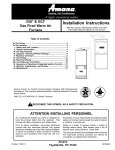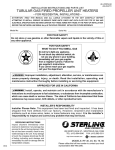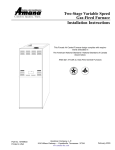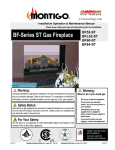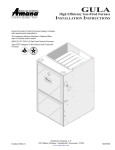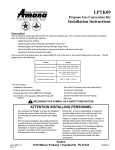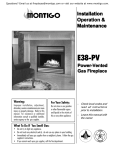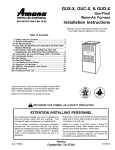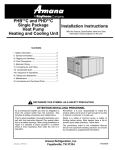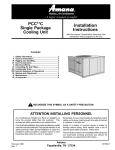Download Amana PGD**C Unit installation
Transcript
® H eating ¡ A ir C onditioning A higher standard of com fort PGA**C, PGB**C and PGD**C Single Package Gas-Electric Heating and Cooling Unit Installation Instructions Affix this manual, Specification Sheet and User Information manual adjacent to the unit. Contents ATTENTION INSTALLING PERSONNEL ............. 1 I. Safety Information ............................................ 2 II. General Information ......................................... 3 III. Rigging and Handling .................................... 3 IV. Gas Piping ....................................................... 4 V. Electrical Wiring ............................................... 7 Vl. Circulating Air and Filters .............................. 8 VII. Venting ........................................................... 9 VIII. Condensate Drain ......................................... 9 IX. Heating Sequence of Operations .................. 9 X. Cooling Sequence of Operations ................. 10 Xl. Startup and Adjustment ............................... 10 XII. Maintenance ................................................ 13 XIII. Accessories and Functional Parts ............ 15 Amana Forced Air Central Units Design Complies With Requirements Embodied in The American National Standard / National Standard of Canada Shown Below. ANSI Z21.47•CAN/CGA-2.3 Central Furnaces RECOGNIZE THIS SYMBOL AS A SAFETY PRECAUTION ATTENTION INSTALLING PERSONNEL As a professional installer you have an obligation to know the product better than the customer. This includes all safety precautions and related items. Prior to actual installation, thoroughly familiarize yourself with this Instruction Manual. Pay special attention to all safety warnings. Often during installation or repair it is possible to place yourself in a position which is more hazardous than when the unit is in operation. product safely and to know it well enough to be able to instruct a customer in its safe use. Safety is a matter of common sense...a matter of thinking before acting. Most dealers have a list of specific good safety practices...follow them. The precautions listed in this Installation Manual should not supersede existing practices but should be considered as supplemental information. Remember, it is your responsibility to install the January1998(1) Amana Fayetteville, TN 37334 10692406 WARNING I. Safety Information To prevent death, personal injury, or property damage due to improper installation, adjustments, alterations, service or maintenance, when servicing or performing maintenance to this unit consult this manual, service manual, qualified installer, service agency or gas supplier. IMPORTANT TO THE INSTALLER Before installing this unit please read this manual and the Specification Sheet to familiarize yourself on the specific items which must be adhered to such as maximum external static pressure to unit, air temperature rise, minimum or maximum CFM and motor speed connections. WARNING TO THE OWNER It is important to complete the owner registration card and mail it immediately. This will assist Amana in contacting you if any service or warranty information should change in the future. When completing the registration card, be sure to include the Model, Manufacturing and Serial Numbers, plus the installation date. This product contains or produces a chemical(s) which may cause death or serious illness and which are known by the State of California to cause cancer, birth defects or other reproductive harm. The warranty certificate is also supplied with the unit. Read the warranty carefully and note what is covered. Keep the warranty certificate in a safe place so you can find it if necessary. IMPORTANT NOTE: This unit must not be used as a “construction heater” during the finishing phases of construction on a new structure. This type of use may result in premature failure of the unit due to extremely low return air temperatures and exposure to very dirty atmospheres. If additional operating instructions are required, call the dealer where the purchase was made. Keep this literature in a safe place for future reference. LOCATING THE UNIT WARNING WARNING To prevent death, personal injury or property damage due to fire or explosion, installation procedures in this manual must be followed exactly. To prevent death, personal injury, property damage or equipment damage, the following points must be observed when installing the unit. WARNING ALL INSTALLATIONS: • For proper flame pattern within the heat exchanger and proper condensate drainage, the unit must be mounted level. • The flue outlet hood must be at least 12 inches from any opening through which flue gases could enter a building, and at least three feet above any forced air inlet located within ten feet. The economizer/manual fresh air intake/ motorized fresh air intake and combustion air inlet mounted on the unit are not affected by this restriction. • To avoid possible corrosion of the heat exchanger, do not locate the unit in an area where the outdoor air (i.e. combustion air for the unit) will be frequently contaminated by compounds containing chlorine or fluorine. Common sources of such compounds include swimming pools and chlorine bleaches, paint stripper, adhesives, paints, varnishes, sealers, waxes (which are not yet dried) and solvents used during construction and remodeling. Various commercial and industrial processes may also be sources of chlorine/fluorine compounds. • To avoid possible illness or death of the building occupants, do NOT locate outside air intake device (economizer, manual fresh air intake, motorized fresh air intake) too close to an exhaust outlet, gas vent termination, or plumbing vent outlet. For specific distances required, consult local codes. Should overheating occur or the gas supply fail to shut off, turn off the manual gas control valve to the unit before shutting off the electrical supply. WARNING To prevent death, personal injury or property damage, do not use this unit if any part of the unit has been under water. Immediately call a qualified service technician to inspect the unit and to replace any part of the control system and any gas control which has been under water. If you smell gas: • Do not try to light appliance. • Do not touch any electrical switch: do not use any phone in building. • Immediately call gas supplier from a neighbor’s phone. Follow gas supplier’s instructions. • If gas supplier cannot be reached, call fire department. 2 • Allow clearances from the enclosure as shown in Speci- of the area to be conditioned. The loads should be calcufication Sheet for fire protection, proper operation, and service access. These clearances must be permanently maintained. The combustion air inlet and flue outlet hoods on the side of the unit must never be obstructed. If used, do not allow the economizer/manual fresh air damper/ motorized fresh air damper to become blocked by snow or debris. In some climates or locations, it may be necessary to elevate the unit to avoid these problems. When the unit is heating, the temperature of the return air entering the unit must be between 50° F and 100° F. Provisions must be made for adequate combustion and ventilation air in accordance with Section 5.3, Air for Combustion and Ventilation, of the National Fuel Gas Code, ANSI Z223.1, or Sections 7.2, 7.3 or 7.4 of CAN/ CGA B149 Installation Codes, or applicable provisions of the local building codes. lated by an approved method or in accordance with A.S.H.R.A.E. Guide or Manual J - Load Calculations published by the Air Conditioning Contractors of America. GROUND LEVEL INSTALLATIONS ONLY: • When the unit is installed on the ground adjacent to the building, a level concrete (or equal) base is recommended. Prepare a base the same physical size as the unit or slightly larger and 3 inches thick. • The base should also be located where no runoff of water from higher ground can collect in the unit. 1. Make notation on delivery receipt of any visible damage to shipment or container. 2. Notify carrier promptly and request an inspection. 3. In case of concealed damage, carrier should be notified as soon as possible-preferably within 5 days. 4. File the claim with the following supporting documents within the 9 month statute of limitations. a. Original Bill of Lading, certified copy, or indemnity bond. b. Original paid freight bill or indemnity in lieu thereof. c. Original invoice or certified copy thereof, showing trade and other discounts or reductions. d. Copy of the inspection report issued by carrier representative at the time damage is reported to the carrier. The carrier is responsible for making prompt inspection of damage and for a thorough investigation of each claim. The distributor or manufacturer will not accept claims from dealers for transportation damage. • • • Obtain from: American National Standards Institute 1430 Broadway New York, NY 10018 TRANSPORTATION DAMAGE All units are securely packed in shipping containers approved by the International Safe Transit Association. The carton should be checked upon arrival for external damage. If damage is found, a request for inspection by carrier agent should be made in writing immediately. The unit should be carefully inspected upon arrival for damage and bolts or screws which may have loosened in transit. In the event of damage, the consignee should: ROOFTOP INSTALLATIONS ONLY: • To avoid possible personal injury or property damage, the roof must have sufficient structural strength to carry the weight of the unit(s) and snow or water loads as required by local codes. • The unit may be installed directly on wood floors or on Class A, Class B, or Class C roof covering material. • To avoid possible personal injury, a safe, flat surface for service personnel should be provided. NOTE: Refer to Specification Sheet shipped with the unit or the unit Rating Plate for approved duct orientation, before using down discharge openings. NOTE: When inspecting the unit for transportation damage, remove all packaging materials. Recycle or dispose the packaging material according to local codes. II. General Information WARNING III. Rigging and Handling To prevent death, personal injury or property damage due to fire, explosions, smoke, soot, condensation, electric shock or carbon monoxide, this unit must be properly installed, repaired, operated and maintained. CAUTION To prevent property damage, the unit should remain in an upright position during all rigging and moving operations. To facilitate lifting and moving when a crane is used, place the unit in an adequate cable sling. This unit is approved only for an outdoor installation. To assure that your unit operates safely and efficiently, it must be installed, operated, and maintained in accordance with these installation and operating instructions, all local building codes and ordinances, or in their absence, with the latest edition of the National Fuel Gas Code. (ANSI Z223.1) and National Standard of Canada (CAN/CGA-2.3). NOTE: Refer to Specification Sheet shipped with the unit or the unit Rating Plate for approved duct orientation, before using down discharge openings. Important: If using bottom discharge with roof curb, ductwork should be attached to the curb prior to installing the unit. Ductwork dimensions are shown in roof curb installation instructions. The heating and cooling capacities of the unit should be greater than or equal to the design heating and cooling loads 3 Refer to the Roof Curb Installation Instructions for proper curb installation. Curbing must be installed in compliance with the National Roofing Contractors Association Manual. The minimum supply pressure should not vary from that shown in the table above because this could prevent the unit from having dependable ignition. In addition, gas input to the burners must not exceed the rated input shown on the rating plate. Overfiring of the unit could result in premature heat exchanger failure. Lower unit carefully onto roof mounting curb. While rigging unit, center of gravity will cause condenser end to be lower than supply air end. If using a fork lift, see Figure 1 for location of fork prongs. Make certain prongs support unit weight. HIGH ALTITUDE DERATE (US. INSTALLATIONS ONLY) IMPORTANT NOTE: The gas/electric units will naturally derate itself with altitude. Do not attempt to increase the firing rate by changing orifices or increasing the manifold pressure. This can cause poor combustion and equipment failure. Fork Lift From Back Of Unit At all altitudes, the manifold pressure must be within 0.3 inches W.C. of that listed on the “Specification Sheet” for the fuel used. At all altitudes and with either fuel, the air temperature rise must be within the range listed on the unit nameplate. Refer to the “Specification Sheet” for kits for conversion from natural gas to propane gas and for altitude adjustments. PIPING IMPORTANT NOTE: To avoid possible unsatisfactory operation or equipment damage due to under firing of equipment, do not undersize the natural/propane gas piping from the meter/tank to the unit. When sizing a trunk line as shown in Table 2, include all appliances on that line that could be operated simultaneously. Figure 1 Rigging The rating plate is stamped with the model number, type of gas and gas input rating. Make sure the unit is equipped to operate on the type of gas available. IV. Gas Piping IMPORTANT NOTE: This unit is factory set to operate on natural gas at the altitudes shown on the rating plate. The gas line installation must comply with local codes, or in the absence of local codes, with the latest edition of the National Fuel Gas Code (ANSI Z223.1). WARNING To prevent death, personal injury or property damage when either using propane gas alone or at higher altitudes, obtain and install the proper conversion kit(s). Failure to do so can result in unsatisfactory operation and/or equipment damage. High altitude kits are for U.S. installations only and are not approved for use in Canada. NATURAL GAS CONNECTION Natural Gas Capacity of Pipe in Cubic Feet of Gas Per Hour (CFH) Nominal Black Pipe Size (inches) Length of Pipe in Feet 1/2 3/4 1 1 1/4 1 1/2 10 132 278 520 1050 1600 20 92 190 350 730 1100 30 73 152 285 590 980 40 63 130 245 500 760 50 56 115 215 440 670 60 50 105 195 400 610 70 46 96 180 370 560 80 43 90 170 350 530 90 40 84 160 320 490 100 38 79 150 305 460 Pressure = .50 PSIG or less and Pressure Drop of 0.3" W.C. (Based on 0.60 Specific Gravity Gas) The rating plate is stamped with the model number, type of gas and gas input rating. Make sure the unit is equipped to operate on the type of gas available. Inlet Gas Pressure Natural Propane Min. 5.0" W.C., Max. 10.0" W.C. Min. 11.0" W.C., Max. 13.0" W.C. Inlet Gas Pressure Must Not Exceed the Maximum Value Shown in Table Above. CFH = BTUH Furnace Input Heating Value of Gas (BTU/Cubic Foot) Table 1 Table 2 4 Refer to Figure 2 for the general layout at the unit. The CHECKING THE GAS PIPING following rules apply: CAUTION 1. Use black iron or steel pipe and fittings for the building piping. 2. Use pipe joint compound on male threads only. Pipe joint compound must be resistant to the action of the fuel used. 3. Use ground joint unions. 4. Install a drip leg to trap dirt and moisture before it can enter the gas valve. The drip leg must be a minimum of three inches long. 5. Use two pipe wrenches when making connection to the gas valve to keep it from turning. 6. Install a manual shut-off valve in a convenient location (within six feet of unit) between the meter and the unit. To prevent personal injury or property damage due to fire, the following instructions must be performed regarding gas connections and pressure testing: • The unit and its gas connections must be leak tested before placing in operation. Because of the danger of explosion or fire, never use a match or open flame to test for leaks. Never exceed specified pressures for testing. Higher pressure may damage gas valve and cause overfiring which may result in premature heat exchange failure. 7. Tighten all joints securely. 8. The unit must be connected to the building piping by one of the following methods: • Rigid metallic pipe and fittings • Semirigid metallic tubing and metallic fittings (Aluminum alloy tubing must not be used in exterior locations) • Listed gas appliance connectors used in accordance with the terms of their listing that are completely in the same room as the equipment • In the prior two methods above the connector or tubing must be protected from physical and thermal damage. Aluminum alloy tubing and connectors must be coated to protect against external corrosion when in contact with masonry, plaster or insulation or are subject to repeated wettings by liquids (water - not rain water, detergents or sewage) • This unit and its shut-off valve must be disconnected from the gas supply during any pressure testing of that system at test pressures in excess of 1/2 PSIG (3.48 kPa). • This unit must be isolated from the gas supply system by closing its manual shutoff valve during any pressure testing of the gas supply piping system at test pressures equal to or less than 1/2 PSIG (3.48kPa). WARNING Manual Shut-Off Valve To avoid personal injury or property damage, be sure there is no open flame in the vicinity during air bleeding procedure. Gas Valve There will be air in the gas supply line after testing for leaks on a new installation. Therefore, the air must be bled from the line by loosening the ground joint union until pure gas is expelled. Tighten union and wait for five minutes until all gas has been dissipated in the air. Be certain there is no open flame in the vicinity during air bleeding procedure. The unit is placed in operation by closing the main electrical disconnect switch for the unit. Drip Leg Ground Joint Union (Installed Ahead Of Gas Valve) Reduce coupling 1/2" x 1/8", with 1/8" pipe plug to measure line gas pressure. Figure 2 Proper Piping Practice 5 TANKS AND PIPING FOR PROPANE GAS INSTALLATIONS WARNING To prevent death, personal injury or property damage due to fire or explosion caused by a propane gas leak, install a gas detecting warning device. Since rust can reduce the level of odorant in propane gas, a gas detecting warning device is the only reliable way to detect a propane gas leak. Contact a local propane gas supplier about installing a gas detecting warning device. IMPORTANT NOTE: Propane gas conversion kits must be installed to convert units to propane gas. See Specification Sheet for kit part number for this model. All propane gas equipment must conform to the safety standards of the National Board of Fire Underwriters (See NBFU Manual 58). For satisfactory operation, propane gas supply pressure must be 10 inch W.C. at the unit manifold with all gas appliances in operation. Maintaining proper gas pressure depends on three main factors: 1. Vaporization rate, which depends on (a) temperature of the liquid, and (b) wetted surface area of the container or containers. 2. Proper pressure regulation. 3. Pressure drop in lines between regulators, and between second stage regulator and the appliance. Pipe size required will depend on length of pipe run and total load of all appliances. Table 3 Propane Gas Pipe Sizing Complete information regarding tank sizing for vaporization, recommended regulator settings and pipe sizing is available from most regulator manufacturers and propane gas suppliers. WARNING To prevent death, serious personal injury or property damage due to fire or explosion caused by a propane gas leak, install a gas detecting warning device. If the propane gas unit is installed in an excavated area or a confined space, a warning device is required due to: • Propane gas is heavier than air and any leaking gas can settle in any low areas or confined spaces. • Propane gas odorant may fade, making the gas undetectable except with a warning device. If the presence of gas is suspected, follow the instructions on Page 2 of this manual. Since propane gas will quickly dissolve white lead or most standard commercial compounds, special pipe dope must be used. Shellac base compounds resistant to the actions of liquefied petroleum gases such as Gasolac, Stalactic, Clyde’s or John Crane are satisfactory. Please refer to Figure 3 for typical propane gas installations. Figure 3 Typical Propane Gas Piping 6 Refer to the unit wiring diagram for electrical connections. When installed, the unit must be electrically grounded in accordance with local codes or in the absence of local codes, with the National Electrical Code, ANSI/NFPA No. 70, and/or the CSA C22.1 Electrical Code, if an external source is utilized. V. Electrical Wiring LOCATING THE THERMOSTAT Thermostat should be mounted 5 feet above the floor, on a vibration free inside wall in a room or a hallway that has good air circulation. Movement of air should not be obstructed by furniture, door, draperies, etc. The thermostat should not be mounted where it will be affected by drafts, hot or cold water pipes or air ducts in walls, radiant heat from fireplace, lamps, the sun, television, etc. Consult the Instruction Sheet packaged with thermostat for mounting instructions. WARNING To avoid death or personal injury due to electrical shock, wiring to the unit must be properly grounded. CAUTION All units have one stage of heating and one stage of mechanical cooling. Units which will have economizers may use thermostats with one or two stages of cooling. To avoid personal injury or property damage due to fire, use only copper conductors. WARNING CAUTION To avoid death or personal injury due to electrical shock, disconnect the electrical power before electrically connecting the unit. To prevent improper and dangerous operation due to wiring errors, label all wires prior to disconnection when servicing controls. Verify proper operation after servicing. The units are designed for operation on 60 hertz current and at voltages as shown on the rating plate. All internal wiring in the unit is complete. It is necessary to bring in the power supply to the contactor as shown on the unit wiring diagram which is supplied with each unit. 24 volt wiring must be connected between the unit control panel and the room thermostat. Refer to Figure 4 for location of low voltage terminal board and Figure 6 for proper thermostat wiring. UNUSED DI MOTOR LEADS S 2 S S NEUTRAL COOL 1 C XFMR All line voltage connections must be made through weatherproof fittings. All exterior power supply and ground wiring must be in approved weatherproof conduit. Low voltage wiring from the unit control panel to the thermostat requires coded cable. For ground level and rooftop wiring refer to Figure 5. X SEC HEAT 3 The best protection for the wiring is the lowest rated fuse or circuit breaker which will supply power to the unit during normal operation without nuisance trips. Such a device will provide maximum circuit protection. DO NOT EXCEED THE MAXIMUM OVERCURRENT DEVICE SIZE SHOWN ON UNIT DATA PLATE. CIR BLOWER F1 C G Y W R 120 06 150 HEAT FAN DELAY OFF 60 Y C Low Voltage Terminal Board Figure 4 Low Voltage Control Board 7 G Y R W From Unit R W Y G Figure 6 Typical Thermostat and Unit 24 V Wiring Hookup Electrical Power Directly To Junction Box Vl. Circulating Air and Filters AIRFLOW CONVERSION Units can easily be converted from horizontal to vertical airflow delivery. Units will ship from the factory ready for horizontal airflow. If conversion to vertical airflow is necessary, proceed as follows: NOTE: Refer to Specification Sheet shipped with the unit or the unit Rating Plate for approved duct orientation, before using down discharge openings. • Cut insulation around bottom openings and remove • panels from the bottom of the unit, saving the screws holding the panels in place. Use horizontal duct cover kit. Electrical Power Routed Through Bottom of Unit Figure 5 Typical Electrical Wiring UNIT VOLTAGE The unit transformer is factory connected for 230V operation. If the unit is to operate on 208V, reconnect the transformer primary lead and induced draft blower motor leads as shown on the unit wiring diagram. Figure 7 Horizontal Duct Cover Kit HEAT ANTICIPATOR SETTING The heat anticipator in the room thermostat must be correctly adjusted to obtain the proper number of heating cycles per hour and to prevent the room temperature from overshooting the room thermostat setting. Heat anticipator must be set at 0.4 amps. DUCTWORK Duct systems and register sizes must be properly designed for the C.F.M. and external static pressure rating of the unit. Ductwork should be designed in accordance with the recommended methods of Air Conditioning Contractors of America Manual D (Residential) or Manual Q (Commercial). 8 To install the flue hood cover: All ductwork exposed to the outdoors must include a weatherproof barrier and adequate insulation. 1. Remove the flue hood and bug screen from inside the heating compartment. 2. Attach the flue hood and screen with the sheet metal screw provided. A duct system should be installed in accordance with Standards of the National Board of Fire Underwriters for the Installation of Air Conditioning, Warm Air Heating and Ventilating Systems. Pamphlets No. 90A and 90B. To install the air inlet hood: The warm air supply duct from the unit through a wall fabricated of combustible material may be installed without clearance. However, minimum clearances for the unit must be observed as shown in Specification Sheet. 1. Remove hood from the heating compartment. 2. Attach hood by using the supplied sheet metal screws. The outlet duct should be provided with an access panel. This access should be large enough to inspect the air chamber downstream from the heat exchanger for any smoke or combustion gas leaks. A cover should be tightly attached to prevent air leaks. Flue Hood Screen For horizontal airflow, duct flange dimensions on the unit are shown in Specification Sheet. For vertical airflow, the ductwork should be attached to the roof curb prior to installing the unit. Ductwork dimensions are shown in the roof curb installation manual. If desired, supply and return duct connections to the unit may be made with flexible connections to reduce possible unit operating sound transmission. Air Intake Hood FILTERS Figure 8 Air Inlet Hood and Flue Hood CAUTION To prevent property damage due to fire and loss of equipment efficiency or equipment damage due to dust and lint build up on internal parts, never operate unit without an air filter installed in the return air system. VENTING NOTE: Venting is self-contained. Do not modify or block. VIII. Condensate Drain CONDENSATE DRAIN CONNECTION This unit has a built in trap - no external trap is required. Even though a return air filter is not supplied with this unit, there must be a means of filtering all return air. To avoid double trapping and an overflowing drain pan, soft plastic drain lines are not recommended. Refer to Specification Sheet provided with unit for filter size information. IX. Heating Sequence of Operations If using the Over/Under Transition Kit, the filter(s) may be located in the return air duct(s) or return air filter grille(s). Filters installed external to the unit should be sized in accordance with their manufacturer recommendations. A throwaway filter must be sized for a maximum face velocity of 300 feet per minute. NORMAL SEQUENCE OF OPERATION - HEATING 1. Thermostat calls for heat. The combustion blower is immediately energized. 2. The pressure switch contacts transfer. 3. The ignitor is energized and pilot gas begins to flow. 4. After pilot flame is proven, the main valve is energized and the pilot will light the main burners. 5. The control checks the signal from the flame sensor. Gas flow will continue only if a proper signal is present. As soon as pilot flame is proven, the ignitor is deenergized. 6. The unit will continue to fire for 30 seconds. The fan control will then start the main circulating air blower. 7. The unit will deliver heat to the conditioned space until the thermostat is satisfied. FILTER INSTALLATION Important: When installing a filter, the air flow arrows on the filter must point at the indoor blower. VII. Venting FLUE HOOD AND AIR INLET HOOD INSTALLATION Install the flue hood and air inlet hood prior to operation of the unit. See Figure 8. 9 8. The gas valve and combustion blower will be deenergized when the thermostat opens. 9. There is an adjustable Heat Fan OFF of approximately 60/90/120/150 second delay (factory set at 120). The control module will de-energize the blower once the selected time has elapsed. This allows any additional heat in the heat exchanger to be transferred to the conditioned space. WARNING To prevent death, personal injury or property damage due to fire or explosion, before manually resetting the roll-out protection device, a qualified servicer must investigate the reason for the roll-out protection device to open. X. Cooling Sequence of Operations NORMAL SEQUENCE OF OPERATIONS - COOLING 1. Thermostat calls for cooling. The compressor and outdoor fan are energized. 2. Approximately six seconds later, the indoor fan starts. 3. The unit will deliver cooling to the conditioned space until the thermostat is satisfied. 4. The compressor and outdoor fan will be de-energized when the thermostat opens. 5. The indoor fan continues to run for approximately 30 seconds after the thermostat is satisfied. This allows additional cooling from the indoor coil to be transferred to the conditioned space. Then, the indoor fan stops. Roll-Out Protector Burner Box Figure 9 Rollout Protection Xl. Startup and Adjustment SECONDARY LIMIT CONTROL A second limit control is placed on the blower scroll. This control will open due to elevated temperature caused by the blower failing. The reason for elevated temperatures at the control should be determined and repaired prior to resetting this manual reset control. The secondary limit control is located on the top of the blower scroll assembly. (Figure 10) HEATING STARTUP GENERAL INFORMATION This unit is equipped with an electronic ignition device to light the pilot which then lights the burners. It also has a power vent blower to exhaust combustion products. On new installations, or if a major component has been replaced, the operation of the unit must be checked. If the power to the unit is interrupted during the heating cycle, it may cause the secondary limit to trip. To reset, press the red button on the limit. Check unit operation as outlined in the following instructions. If any sparking, odors, or unusual sounds are encountered, shut off electrical power and recheck for wiring errors, or obstructions in or near the blower motors. Duct covers must be removed before operating unit. Secondary Limit Control Reset Button ROLL-OUT PROTECTION CONTROL If the flames from the burners are not properly drawn into the heat exchanger, a roll-out protection device will open, cutting power to the gas valve. The roll-out protection device is located on the side of burner box (Figure 9). The reason for elevated temperatures at the control should be determined and repaired prior to resetting this manual reset control. Condenser Coil Duct Opening HEAT ANTICIPATOR SETTING The heat anticipator in the room thermostat must be correctly adjusted to obtain the proper number of heating cycles per hour and to prevent the room temperature from overshooting the room thermostat setting. Heat anticipator must be set at 0.4 amps. Blower Assembly Blower Compartment Access Door Figure 10 Secondary Limit Control (Top View) 10 OPERATING INSTRUCTIONS (HEATING) NOTE: Figure 2 illustrates the proper gas valve mounting location. GAS INPUT AND PRESSURES Gas supply pressure and manifold pressure with the burners operating must be as specified on the rating plate. GAS PRESSURE CHECKS Gas inlet pressure must be checked and adjusted in accordance to the type of fuel being consumed. WITH POWER AND GAS OFF: 1. Connect a water manometer or adequate gauge to the inlet pressure tap of the gas valve. OFF Inlet gas pressure can also be measured by removing the cap from the dripleg and installing a predrilled cap with a hose fitting(Figure 14). ON WITH POWER AND GAS ON: 2. Put unit into heating cycle and turn on all other gas consuming appliances. Figure 11 Honeywell Gas Valve SV9500 (Top View) Natural Propane Inlet Gas Pressure Min. 5.0" W.C., Max. 10.0" W.C. Min. 11.0" W.C., Max. 13.0" W.C. IN OFF ON CONTROL Figure 13 Inlet Gas Pressure ½PSI IGNITOR Note: Inlet Gas Pressure Must Not Exceed the Maximum Value Shown. If operating pressures differ from above, make necessary pressure regulator adjustments, check piping size, etc., and/or consult with local utility. Figure 12 Honeywell Gas Valve SV9501 (Top View) 1. Close the manual gas valve external to the unit. 2. Turn off the electrical power supply to the unit. 3. Set the room thermostat to its lowest possible setting. 4. Remove the heat exchanger door on the side of the unit by removing screws. 5. This unit is equipped with an ignition device which automatically lights the pilot. Do NOT try to light burner by any other method. 6. Turn the gas control valve knob or switch to the OFF position. Do not force. (Figures 11 or 12) 7. Wait five minutes to clear out any gas. 8. Smell for gas, including near the ground. This is important because some types of gas are heavier than air. If you have waited five minutes and you do smell gas, immediately follow the instructions on the Page 2 of this manual. If having waited for five minutes and no gas smell is noted, turn the gas control valve knob or switch to the ON position. (Figures 11 or 12) 9. Replace the heat exchanger door on the side of the unit. 10. Open the manual gas valve external to the unit. 11. Turn on the electrical power supply to the unit. 12. Set the thermostat to desired setting. Figure 14 Measuring Inlet Gas Pressure Alternate Method CHECK THE MANIFOLD PRESSURE A tapped opening is provided in the gas valve to facilitate measurement of the manifold pressure. A “U” Tube manometer having a scale range from 0 to 12 inches of water should be used for this measurement. The manifold pressure must be measured with the burners operating. 11 2. The temperature rise must be within the range specified on the rating plate. To adjust the pressure regulator, remove the adjustment screw or cover on the gas valve. Turn out (counterclockwise) to decrease pressure, turn in (clockwise) to increase pressure. Only small variations in gas flow should be made by means of the pressure regulator adjustment. In no case should the final manifold pressure vary more than plus or minus 0.3 inches water column from the specified pressure. Any major changes in flow should be made by changing the size of the burner orifices. The measured input rate to the furnace must not exceed the rating specified on the unit rating plate. NOTE: Air temperature rise is the temperature difference between supply and return air. With a properly designed system, the proper amount of temperature rise will normally be obtained when the unit is operated at rated input with the recommended blower speed. If the correct amount of temperature rise is not obtained, it may be necessary to change the blower speed. A higher blower speed will lower the temperature rise. A slower blower speed will increase the temperature rise. For natural gas, the manifold pressure must be between 3.0 and 3.6 inches water column (3.5 nominal). NOTE: Blower speed MUST be set to give the correct air temperature rise through the unit as marked on the rating plate. For propane gas, the manifold pressure must be between 9.7 and 10.3 inches water column (10.0 nominal). CHECK THE GAS INPUT (NATURAL GAS ONLY) NOTE: On outdoor equipment, the gas input will vary with the temperature of the gas. Rated input will be obtained at approximately 10° F. With warmer ambient and gas temperatures, the input will decrease. Example: At 70° F the input will decrease 12%. CHECKING EXTERNAL STATIC PRESSURE The total external static pressure must be checked on this unit to determine if the airflow is proper. CHANGING BLOWER SPEEDS WARNING To measure the gas input using the gas meter proceed as follows: To avoid death or personal injury due to electric shock, remove electrical power from the unit before changing speed taps on the blower motor. 1. Turn off gas supply to all other appliances except the unit. 2. With the unit operating, time the smallest dial on the meter for one complete revolution. If this is a 2 cubic foot dial, divide the seconds by 2; if it is a 1 cubic foot dial, use the seconds as is. This gives the seconds per cubic foot of gas being delivered to the unit. 3. INPUT=GAS HTG VALUE x 3600 / SEC. PER CUBIC FOOT Refer to the wiring diagram on the unit to verify speed tap settings. Blower speeds can be changed on the fan timer board. Both heat speed and cool speed terminals are supplied on the board along with two unused motor lead terminals (Figure 15). Input = 1000 x 3600 / 34 = 106,000 BTU per Hour. NOTE: BTU content of the gas should be obtained from the gas supplier. This measured input must not be greater than shown on the unit rating plate. 4. Relight all other appliances turned off in step 1. Be sure all pilot burners are operating. 3 S 2 S S UNUSED MOTOR LEADS C NEUTRAL COOL 1 DI CHECK MAIN BURNER FLAME Flames should be stable, soft and blue (dust may cause orange tips but they must not be yellow) and extending directly outward from the burner without curling, floating or lifting off. XFMR X SEC HEAT Example: Natural gas with a heating value of 1000 BTU per cubic foot and 34 seconds per cubic foot as determined by Step 2, then: CIR BLOWER Figure 15 Control Board (Top) CHECK LIMIT Check limit control operation after 15 minutes of operation by blocking the return air grille(s). 1. After several minutes the main burners must go OFF. Blower will continue to run. 2. Remove air restrictions and main burners will relight after a cool down period of a few minutes. CHECK TEMPERATURE RISE Check the temperature rise through the unit by placing thermometers in supply and return air registers as close to the unit as possible. Thermometers must not be able to sample temperature directly from the unit heat exchangers, or false readings could be obtained. 1. All registers must be open; all duct dampers must be in their final (fully or partially open) position and the unit operated for 15 minutes before taking readings. Adjust the thermostat setting below room temperature. 1. Main burners must go off. 12 2. Circulating Air Blower will continue to run for 60, 90, 120 or 150 seconds, depending on the setting. XII. Maintenance NOTE: If necessary, adjust fan OFF delay settings to obtain satisfactory comfort level. WARNING To avoid death or personal injury due to electrical shock, disconnect electrical power before performing any maintenance. CAUTION This unit must not be used as a “construction heater” during the finishing phases of construction on a new structure. This type of use may result in premature failure of the unit due to extremely low return air temperatures and exposure to very dirty atmospheres. Important Note: Touching the ignitor body with bare fingers, rough handling, or vibration could result in early ignitor failure. Only a qualified servicer should ever handle the ignitor. Have the gas heating section of the unit checked at least once a year before the heating season begins, to be sure that the combustion air inlet and flue outlet hoods are not blocked by debris, which would prevent adequate combustion air and a properly operating vent system. TO TURN OFF UNIT 1. Set the thermostat to lowest setting. 2. Turn off the electrical power supply to the unit. 3. Remove the heat exchanger door on the side of the unit by removing screws. 4. Turn the gas control valve knob to the OFF position. Do not force. See Figures 11 and 12. 5. Close manual gas shutoff valve external to the unit. 6. Replace the heat exchanger door on the unit. 7. If cooling and/or air circulation will be desired, turn ON the electrical power. REPLACING OR CLEANING FILTER A return air filter is not supplied with this unit; however, there must be a means of filtering all of the return air. The filter(s) may be located in the return air duct(s), return air filter grille(s). Consult with your installing dealer for the actual location of the return air filter(s) for your unit. Dirty filters are the most common cause of inadequate heating or cooling performance. Filter inspection should be made at least every two months; more often if necessary because of local conditions and usage. Dirty throwaway filters should be discarded and replaced with a new, clean filter. Dirty permanent filters should be washed with water, thoroughly dried and sprayed with a filter adhesive before being reinstalled. (Filter adhesives may be found at many hardware stores.) Permanent filters should last several years. However, should one become torn or uncleanable, it should be replaced. COOLING STARTUP NOTE: Check all manual reset limit controls in heating circuit if cooling mode does not operate. COMPRESSOR PROTECTION DEVICES The compressor includes components which are designed to protect the compressor against abnormal operating conditions. MAINTAINING CABINET FINISH Use a fine grade automotive wax on the cabinet finish to maintain the finish’s original high luster. This is especially important in area’s with high ultraviolet radiation. WARNING To avoid death or personal injury, always disconnect electrical power before inspecting or servicing the unit. All compressor protection devices reset automatically, energizing the contactor and outdoor fan. CLEAN OUTSIDE COIL (QUALIFIED SERVICER ONLY) The coil with the outside air flowing over it should be inspected annually and cleaned as frequently as necessary to keep the finned areas free of lint, hair and debris. CONDENSER, EVAPORATOR, AND INDUCED DRAFT MOTORS Bearings on the air circulating blower motor, condenser motor and the combustion fan motor are permanently lubricated. No additional oiling is required. OPERATING INSTRUCTIONS (COOLING) NOTE: Mechanical cooling cannot be reliably provided at ambient temperatures below 50° F. 1. Turn on the electrical power supply to the unit. 2. Place the room thermostat selector switch in the COOL position (or AUTO if available, and if automatic changeover from cooling to heating is desired). 3. Set the room thermostat to the desired temperature. FLAME SENSOR (QUALIFIED SERVICER ONLY) A drop in the flame sensing signal can be caused by a nearly invisible coating on the flame sensor. This coating, created by the fuel or combustion air supply, can be removed by carefully cleaning the flame sensor with emery cloth or steel wool (Figure 16). 13 NOTE: After cleaning, the microamp signal should be in the range listed in Specification Sheet. Flame Sensor Ignitor Burner Assembly Check the burner flames for: 1. Good adjustment 2. Stable, soft and blue 3. Not curling, floating, or lifting off. Pilot Tube Figure 17 Burner Flame WARNING Figure 16 Ignitor and Flame Sensor To avoid death or personal injury due to electrical shock, do not remove any internal compartment covers or attempt any adjustment. Contact a qualified servicer at once if an abnormal flame appearance should develop. FLUE PASSAGES (QUALIFIED SERVICER ONLY) At the start of each heating season, inspect and, if necessary, clean the unit flue passage. CLEANING FLUE PASSAGES (QUALIFIED SERVICER ONLY) 1. Shut off electric power and gas supply to the unit. 2. Remove burner assembly by disconnecting the gas line and removing the manifold brackets from the partition panel. 3. Remove the flue from the induced draft blower and the collector box from the partition panel. 4. The primary heat exchanger tubes can be cleaned using a round wire brush attached to a length of high grade stainless steel cable, such as drain cleanout cable. Attach a variable speed reversible drill to the other end of the spring cable. Slowly rotate the cable with the drill and insert it into one of the primary heat exchanger tubes. While reversing the drill, work the cable in and out several times to obtain sufficient cleaning. Use a large cable for the large tube, and then repeat the operation with a small cable for the smaller tube. Repeat for each tube. 5. When all heat exchanger tubes have been cleaned, replace the parts in the reverse order in which they were removed. 6. To reduce the chances of repeated fouling of the heat exchanger, perform the steps listed in “Start-up and Adjustment”. At least once a year, prior to or during the heating season, make a visual check of the burner flames. NOTE: This will involve removing and reinstalling the heat exchanger door on the unit, which is held by several screws. If you are uncertain about your ability to do this, contact a qualified servicer. If a strong wind is blowing, it may alter the airflow pattern within the unit enough that an inspection of the burner flames is not possible. CLEANING OF BURNERS 1. Shut off electric power and gas supply to the unit. 2. Remove the screws holding the burner retention bracket in place. 3. Remove the burners. 4. Use a bottle brush to clean burner insert and inside of the burners. 5. Replace burners and burner retention bracket, inspect the burner assembly for proper seating of burners in retention slots. 6. Reconnect electrical power and gas supply. CAUTION MAIN BURNER FLAME (QUALIFIED SERVICER ONLY) Flames should be stable, soft and blue (dust may cause orange tips but must not be yellow). The flames must extend directly outward from the burner without curling, floating or lifting off (Figure 17). Label all wires prior to disconnection when servicing controls. Wiring errors can cause improper and dangerous operation. CAUTION Verify proper operation after servicing. For further information on the yearly inspection, consult the User Manual. It is recommended that a qualified servicer inspect and service the unit at least once each year. 14 Turn the unit on at the thermostat. Wait a few minutes, since any dislodged dust will alter the normal flame appearance. Flames should be predominantly blue and directed into the tubes. They should not be yellow. They should extend directly outward from the burner ports without curling downward, floating or lifting off the ports. XIII. Accessories and Functional Parts SHEET METAL ACCESSORIES Additional Amana accessories, as described in Table 4, can be purchased to fit specific application needs. Accessories can be ordered by the part numbers in the table and each accessory includes its own separate instructions. Accessory Duct Transition Over/Under Horizontal Duct Covers* Compressor Sound Blanket Horizontal Filter Kit Propane Gas Conversion Kit High Altitude Kit * Standard on PGA**C Table 4 Accessory List FUNCTIONAL PARTS Blower Housing Blower Motor Blower Wheel Burner Compressor Condenser Coil Condenser Fan Blade Condenser Fan Motor Contactor Evaporator Coil Fan Timer Board Flame Roll-Out Switch Gas Orifice Heat Exchanger High Limit Switch Secondary Limit Ignitor/Flame Sensor Induced Draft Motor Pressure Switch Pressure Switch Hose Transformer Figure 18 Functional Parts List GENERAL INFORMATION 1. Refer to the description in Figure 18 when ordering any of the listed functional parts. Be sure to provide the unit model, manufacturing, and serial numbers with the order. 2. Although only functional parts are shown in Figure 18, all sheet metal parts, doors, etc. may be ordered by description. 3. Parts are available from your Amana distributor. 15
















